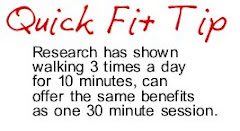
One of the major components of optimal health and probably the most overlooked is flexibility.
Flexibility training or stretching as it is more commonly referred to, takes on several different forms. For our purposes here we are going to focus on Static Stretching. The most beneficial form of stretching to increase elasticity in the muscles, tendons and ligaments is static stretching.
This form of stretching involves slowly moving to a specific position and holding the stretch for 15 to 30 seconds.
Static stretching is best performed after a workout when the soft tissues (muscles, tendons, ligaments) are properly warmed up and are less susceptible to damage or tearing. There are dozens of static stretches and variations on each one and yet I'm the" keep it simple guy" so here are a few that hit most of the major muscle groups involved with walking or jogging or running.
Remember it doesn't have to be complicated to be effective!
1. Calve Stretch

Begin by standing about two shoe lengths away from a chair or wall and leaning your body forward. Move your pelvis toward the chair or wall while keeping your knee on the back leg locked. Hold this position for 15 to 30 seconds and then repeat for the other leg.
2. Achilles Tendon Stretch

Notice that the position is very similar to that for the calve stretch. The exception is that we allow the knee of the back leg to bend forward. You will distinctly feel a difference in where the leg is being stretched with the tension moving from the upper part of the lower leg to the lower half of the lower leg (from your heel up to just below your calve muscles).
Often when running or walking we experience pain on the front part of our lower legs. These pains are commonly clumped under the name "Shin Splints" as they surround the shin area of our legs.
The most common caused of "Shin Splints" is actually tightness in our calves and Achilles tendon. Bottom line... loose lower legs = less pain!
3. Hip Flexor Stretch

One of the areas which most often becomes sore or tender as a result of beginning a new exercise program is the hips. Specifically the muscles known commonly as the hip flexors. Positioned at approximately the point where your pelvis and upper leg come together they are activated every time you raise your leg to take a step.
Put one foot on top of something that is hip height and move your pelvis toward the heel that is raised. Hold this stretch for 15 to 30 seconds. The hip flexor that is being stretched is the one at the top of the leg on the ground. You will likely feel some tension at the top of that leg right at the hip. Keep your upper body and trunk as vertical as possible. Switch legs and repeat.
4. Hamstring Stretch

Put the toes of your front leg against the back of a chair or against the wall. Lean forward toward the chair or wall keeping your front knee locked. Hold for 15 to 30 seconds. Switch legs and repeat. This will help loosen the large muscle on the back of your leg which is responsible for pulling your leg through each stride.
5. Quadriceps Stretch

With one foot on the ground, hold the ankle of the opposite foot and pull up on your heel. Make sure to keep your knees close together and pull your heel as close as possible to your buns. Hold the position for 15 to 30 seconds. Switch legs and repeat. At first it may be very difficult to get your heel to your butt. Give it time and the flexibility will increase.
You are stretching the largest muscle group associated with walking or running with this exercise and so it is natural for it to be stiff in the beginning.
6. Adductor Stretch

Sit on the floor with your legs spread as far apart as possible and your knees straight. Keeping your back as straight as possible from the waist up, bend forward to the center and hold for 15 to 30 seconds. Then bend toward one leg and hold and then the other.
You are stretching your inner thigh muscles which are crucial for stability as you walk or run.
7. Latissimus Dorsi (Lat) Stretch

Stand upright, with your feet just over hip width apart. With one arm reach up over your head and then grab the wrist of that arm with the other hand. Pull downward on the overhead arm and hold for 15 to 30 seconds.
This is stretching the large muscle group in your back below the shoulder blades as well as your shoulder muscles.
I recommend repeating each of the stretches twice.
Many folks undertaking a regular walking or running program for the first time in years may experience a lot of minor aches and pains as they exercise. Much of this soreness or pain is the direct result of muscles which are very tight.
Flexibility training offers a way to minimize many of those initial symptoms of inactivity. It also offers many additional benefits including; increased blood flow to the soft tissues which results in greater availability of oxygen, and a greater capacity to deliver nutrients to the joints and surrounding tissues as well as to remove toxins and waste products generated by the body through energy production.
Of the three main components of optimal health; cardiovascular endurance, muscular strength and flexibility. It is very possible that flexibility ranks number 1 or at least a close second as the most essential for creating a lifetime of optimal health.








No comments:
Post a Comment